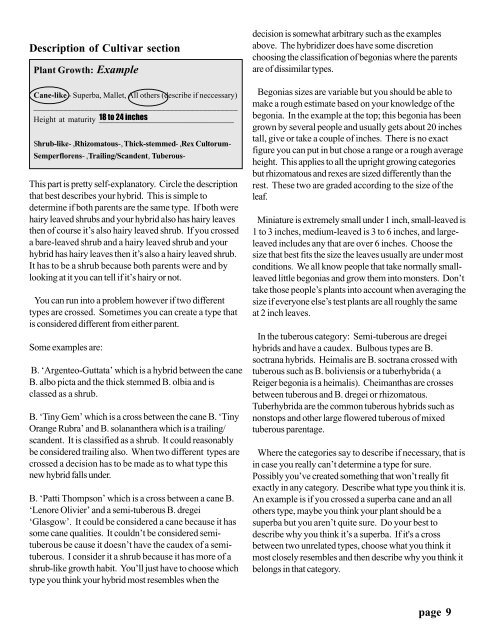Begonia Registration Handbook - American Begonia Society
Begonia Registration Handbook - American Begonia Society
Begonia Registration Handbook - American Begonia Society
You also want an ePaper? Increase the reach of your titles
YUMPU automatically turns print PDFs into web optimized ePapers that Google loves.
Description of Cultivar section<br />
Plant Growth: Example<br />
Cane-like - Superba, Mallet, All others (describe if neccessary)<br />
________________________________________________<br />
Height at maturity _________________________________<br />
18 to 24 inches<br />
Shrub-like- ,Rhizomatous-, Thick-stemmed- ,Rex Cultorum-<br />
Semperflorens- ,Trailing/Scandent, Tuberous-<br />
This part is pretty self-explanatory. Circle the description<br />
that best describes your hybrid. This is simple to<br />
determine if both parents are the same type. If both were<br />
hairy leaved shrubs and your hybrid also has hairy leaves<br />
then of course it’s also hairy leaved shrub. If you crossed<br />
a bare-leaved shrub and a hairy leaved shrub and your<br />
hybrid has hairy leaves then it’s also a hairy leaved shrub.<br />
It has to be a shrub because both parents were and by<br />
looking at it you can tell if it’s hairy or not.<br />
You can run into a problem however if two different<br />
types are crossed. Sometimes you can create a type that<br />
is considered different from either parent.<br />
Some examples are:<br />
B. ‘Argenteo-Guttata’ which is a hybrid between the cane<br />
B. albo picta and the thick stemmed B. olbia and is<br />
classed as a shrub.<br />
B. ‘Tiny Gem’ which is a cross between the cane B. ‘Tiny<br />
Orange Rubra’ and B. solananthera which is a trailing/<br />
scandent. It is classified as a shrub. It could reasonably<br />
be considered trailing also. When two different types are<br />
crossed a decision has to be made as to what type this<br />
new hybrid falls under.<br />
B. ‘Patti Thompson’ which is a cross between a cane B.<br />
‘Lenore Olivier’ and a semi-tuberous B. dregei<br />
‘Glasgow’. It could be considered a cane because it has<br />
some cane qualities. It couldn’t be considered semituberous<br />
be cause it doesn’t have the caudex of a semituberous.<br />
I consider it a shrub because it has more of a<br />
shrub-like growth habit. You’ll just have to choose which<br />
type you think your hybrid most resembles when the<br />
decision is somewhat arbitrary such as the examples<br />
above. The hybridizer does have some discretion<br />
choosing the classification of begonias where the parents<br />
are of dissimilar types.<br />
<strong>Begonia</strong>s sizes are variable but you should be able to<br />
make a rough estimate based on your knowledge of the<br />
begonia. In the example at the top; this begonia has been<br />
grown by several people and usually gets about 20 inches<br />
tall, give or take a couple of inches. There is no exact<br />
figure you can put in but chose a range or a rough average<br />
height. This applies to all the upright growing categories<br />
but rhizomatous and rexes are sized differently than the<br />
rest. These two are graded according to the size of the<br />
leaf.<br />
Miniature is extremely small under 1 inch, small-leaved is<br />
1 to 3 inches, medium-leaved is 3 to 6 inches, and largeleaved<br />
includes any that are over 6 inches. Choose the<br />
size that best fits the size the leaves usually are under most<br />
conditions. We all know people that take normally smallleaved<br />
little begonias and grow them into monsters. Don’t<br />
take those people’s plants into account when averaging the<br />
size if everyone else’s test plants are all roughly the same<br />
at 2 inch leaves.<br />
In the tuberous category: Semi-tuberous are dregei<br />
hybrids and have a caudex. Bulbous types are B.<br />
soctrana hybrids. Heimalis are B. soctrana crossed with<br />
tuberous such as B. boliviensis or a tuberhybrida ( a<br />
Reiger begonia is a heimalis). Cheimanthas are crosses<br />
between tuberous and B. dregei or rhizomatous.<br />
Tuberhybrida are the common tuberous hybrids such as<br />
nonstops and other large flowered tuberous of mixed<br />
tuberous parentage.<br />
Where the categories say to describe if necessary, that is<br />
in case you really can’t determine a type for sure.<br />
Possibly you’ve created something that won’t really fit<br />
exactly in any category. Describe what type you think it is.<br />
An example is if you crossed a superba cane and an all<br />
others type, maybe you think your plant should be a<br />
superba but you aren’t quite sure. Do your best to<br />
describe why you think it’s a superba. If it's a cross<br />
between two unrelated types, choose what you think it<br />
most closely resembles and then describe why you think it<br />
belongs in that category.<br />
page 9


